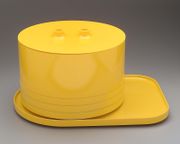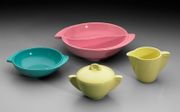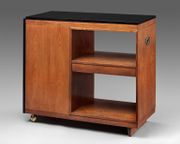Difference between revisions of "Melamine formaldehyde resin"
| (2 intermediate revisions by the same user not shown) | |||
| Line 1: | Line 1: | ||
| + | [[File:MFA1996131 Melamine.jpg|thumb|Melamine plate and bowl<br>MFA 1996.131.1-3]] | ||
== Description == | == Description == | ||
| − | [[File:MFA2010539 Melamine.jpg|thumb| | + | [[File:MFA2010539 Melamine.jpg|thumb|'Boonton' dishes<br>MFA 2010.539]] |
A thermosetting [[amino%20resin|amino resin]] that is made by reacting melamine with [[formaldehyde|formaldehyde]]. First made in 1933 by CIBA, melamine formaldehyde resins were most often used for molded plastic products and were filled with [[cellulose|cellulose]], [[wood%20flour|wood flour]], or mineral powders. They produce a hard, high gloss plastic that was used for utensils, containers, dishware ([[Melmac|Melmac]]) and countertops ([[Formica|Formica®]]). Melamine formaldehyde resins are also used for [[plywood|plywood]], textile sizing, leather processing, and paper strengthening. They are resistant to water and biodegradation. | A thermosetting [[amino%20resin|amino resin]] that is made by reacting melamine with [[formaldehyde|formaldehyde]]. First made in 1933 by CIBA, melamine formaldehyde resins were most often used for molded plastic products and were filled with [[cellulose|cellulose]], [[wood%20flour|wood flour]], or mineral powders. They produce a hard, high gloss plastic that was used for utensils, containers, dishware ([[Melmac|Melmac]]) and countertops ([[Formica|Formica®]]). Melamine formaldehyde resins are also used for [[plywood|plywood]], textile sizing, leather processing, and paper strengthening. They are resistant to water and biodegradation. | ||
| Line 8: | Line 9: | ||
Commercial products: Melamine; Melmac; Meladur; Prolon; Formica® [Formica]; Texasware; Boontonware | Commercial products: Melamine; Melmac; Meladur; Prolon; Formica® [Formica]; Texasware; Boontonware | ||
| − | + | [[File:formica black.jpg|thumb|Formica on Server<br>MFA#: 93.1108]] | |
== Risks == | == Risks == | ||
Latest revision as of 11:54, 4 December 2020
Description
A thermosetting Amino resin that is made by reacting melamine with Formaldehyde. First made in 1933 by CIBA, melamine formaldehyde resins were most often used for molded plastic products and were filled with Cellulose, Wood flour, or mineral powders. They produce a hard, high gloss plastic that was used for utensils, containers, dishware (Melmac) and countertops (Formica®). Melamine formaldehyde resins are also used for Plywood, textile sizing, leather processing, and paper strengthening. They are resistant to water and biodegradation.
Synonyms and Related Terms
melamine; amino resin; melamine-formaldehyde resin
Commercial products: Melamine; Melmac; Meladur; Prolon; Formica® [Formica]; Texasware; Boontonware
Risks
- Evolves formaldehyde and ammonia as it degrades.
- May fade or discolor
- Scratches easily
Physical and Chemical Properties
Resistant to water, acids, bases and organic solvents. Density = 1.5
Comparisons
General Characteristics of Polymers
Physical Properties for Selected Thermoset Resins
Resources and Citations
- History of Plastics: www.nswpmith.com.au/historyofplastics.html .. commercial processes for melamine synthesis patented in 1933 (CIBA) and 1946 (DUPONT).
- Sharon Blank, An introduction to plastics and rubbers in collections, Studies in Conservation, 35, 53-63, 1990 Comment: Introduced in 1934
- G.S.Brady, Materials Handbook, McGraw-Hill Book Co., New York, 1971
- Richard S. Lewis, Hawley's Condensed Chemical Dictionary, Van Nostrand Reinhold, New York, 10th ed., 1993
- Pam Hatchfield, Pollutants in the Museum Environment, Archetype Press, London, 2002


